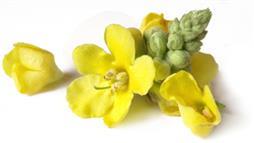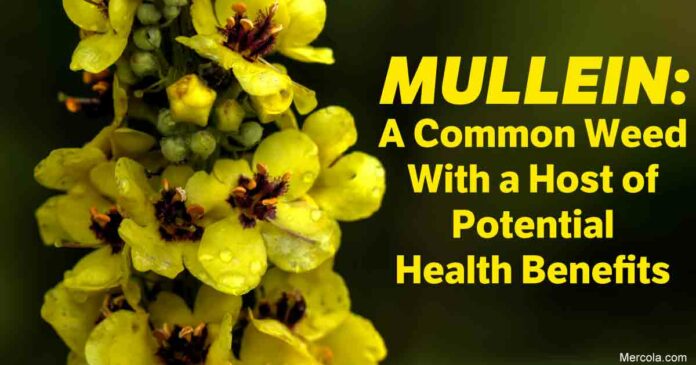Mullein: A Common Weed With a Host of Potential Health Benefits

Story at-a-glance
- Mullein is a flowering plant that is classified as a weed because it spreads quickly throughout gardens and public areas
- Mullein has around 300 species and is native to Europe, Asia and North Africa. The common mullein (Verbascum thapsus) is perhaps the most well-known variant of the plant, due to its history of medical use among various cultures
The mullein plant (Verbascum) is a biennial introduced in the United States during the 18th century by settlers.1 Due to its quick rate of spreading in certain areas such as western North America,2 it has earned a reputation as an undesirable weed in gardens.3
Its common name is derived from the Latin word “mollis,” meaning soft, which most likely refers to its soft stem and leaves.4 Its botanical name, on the other hand, comes from the Latin “barbascum,” which means beard — a reference to the plant’s shaggy appearance.5
This plant is also known as candlewick plant, lungwort, cowboy toilet paper, torch plant and woolly mullein, to name a few.6
Mullein has around 300 species and is native to Europe, Asia and North Africa. On the first year, the plant does not bloom flowers. But on the second year, a single stalk (where the flowers appear) grows upward from the center, ranging from 18 inches to 8 feet, depending on the species. The leaves typically grow within one year, and the flowers grow in the next year.7
The common mullein (Verbascum thapsus) is perhaps the most well-known variant of the plant, due to its history of medical use among various cultures.8
The Health Benefits of Mullein
The medicinal benefits of mullein were discovered quite early on. Early American settlers brought it from Europe because it was known for its ability to help treat various ailments such as coughs and diarrhea.9 When the Native Americans established contact with the settlers and discovered the plant, they took advantage of it as well.10 Some of the potential usage benefits of mullein are for the following:
• Respiratory Conditions — One of the most well-known uses of mullein is its purported ability to help alleviate respiratory conditions. Taken as a tea, it can help with common ailments such as dry cough, congestion and sore throat. It may help with inflammatory respiratory conditions, such as asthma and bronchitis as well.11
• Antiseptic — The antibacterial compounds of mullein can be used to help disinfect wounds or scrapes. You can crush mullein flowers to make a paste, and apply it on your wounds.12
• Antiviral — Mullein may help ease viral infections. According to one study, compounds extracted from V. thapsus showed potential against the Herpes simplex virus type 1, as well as the influenza A virus.
• Heart Health — According to an animal study that used mice as the test subjects, the polysaccharides of the leaves extracted from V. thapsus exhibited a noticeable ability to reduce bad cholesterol and triglyceride levels. It’s unclear how the leaves work, but the researchers suggest that using it may help lower your risk of developing hypertension, atherosclerosis and coronary heart disease.13
• Hair Health — Mullein can help promote hair health. Extracts from the flowers can be used to keep your scalp healthy, as well as eradicate dandruff. It may even be used as a conditioner to help keep your hair smooth and help enrich your hair’s natural color.14
Different Ways Mullein Is Used
In America, mullein is considered a weed because it is not native to the continent, and it propagates very quickly in some areas with bright sun. However, certain species are used in enhancing the aesthetics of gardens due to their beautiful appearance, such as:15
• Moth mullein (V. blattaria) — Known for its light pink to white flowers
• Olympic or Greek mullein (V. olympicum) — It has golden-yellow flowers and 8-foot branching stalks
• Purple mullein (V. phoeniceum) — Popular for its long-blooming flowers
• Nettle-leaf mullein (V. chaixii) — Known for its long-blooming white or yellow flowers with a purple center
Historically, mullein has been used for practical purposes. For example, it was known as the “candlewick plant” because its leaves and stems were used as lamp wicks. According to John Parkinson, an English botanist from the Middle Ages, the plant itself was also used as a torch by dipping its stalk in suet, a type of animal fat, to provide light for various needs.16
Mullein has played a role in superstitious beliefs as well. It was called “hag’s taper” because it was believed that witches used the plant as lamps or candles during their incantations. In other parts of Europe and Asia, it was believed that mullein had the power to protect from evil spirits and magic.
Greek literature may have played a role in this regard, because according to legend, Ulysses used mullein to help ward off the influence of Circe, the Greek goddess of magic.17
Growing Mullein in Your Garden
If you have very little experience in gardening, growing mullein is a great plant to start with because it’s easy to grow and maintain. Being a weed, the plant can thrive almost anywhere, from fertile forest soil to bare, rocky soil found near cliffs.18
Start by placing a pinch of seeds 18 inches apart in your garden bed, placing them lightly on top of the soil. The soil should have good drainage, because excessively moist soil can affect the plant quality. The plants can grow in light shade but, if possible, they should be exposed fully in the sun.19 The plants need very little watering. You can water them daily, but never keep the soil consistently soggy.20
According to the University of Wisconsin’s Extension Master Gardener Program, many beneficial insects, including bees, flies and butterflies, are particularly attracted to mullein’s flowers,21 which makes pollination for mullein and other flowering plants easy. However, other insects attracted to mullein, such as thrips and weevils — and one called the “mullein bug” — can pose serious problems for nearby flowering food plants such as apple and pear trees.22,23,24
Interestingly, grazing mammals do not go near the mullein plant because the leaves can irritate their mucous membranes.25 The only other thing you need to watch out for while growing mullein is removing the rosettes as they grow.26 That’s because a fully grown mullein plant contains 100,000 to 180,000 seeds that can be scattered by the wind. They can lay dormant for many years and if they germinate, you will have a big gardening problem on your hands.27
Mullein Recipe: How to Make Mullein Tea
One way of taking advantage of mullein’s benefits is using it to make tea. In fact, it’s one of the oldest ways of consuming mullein. Best of all, it’s very easy to prepare.28
Mullein Tea
Ingredients:
• 1 1/2 cups of water
• 1 to 2 teaspoons of dried mullein leaves or flowers (the flowers provide a sweeter flavor)
• 1 teaspoon of dried spearmint for flavor (optional)
• 1 to 2 teaspoons of raw honey for flavor (optional)
Procedure:
1. Boil the water and steep the leaves in it (using a tea bag or ball) for 15 minutes.
2. Add the spearmint and/or the honey for flavor (optional).
3. Serve and enjoy.
Creating Mullein Infused Oil at Home
Mullein flowers can be used to create an infused oil, which can have various medicinal purposes. You can easily create it in the comfort of your own home using very few ingredients, making it a mainstay in your medicine cabinet.29
Mullein Infused Oil at Home
What You Will Need:
• Dried mullein flowers (you can use fresh flowers as well)
• Extra virgin olive oil
• A glass jar (the size is up to your preference)
Procedure:
1. Place your desired amount of flowers in the jar.
2. Pour enough oil until it covers the flowers, then cover the jar. If you’re using fresh flowers, use a cheesecloth to cover the jar, allowing the moisture to escape.
3. If you’re using dried flowers, leave the jar in a dark, cool cabinet for four to six weeks. If you’re using fresh flowers, place the jar under the sun for three days without the lid.
4. Strain the oil in a new jar three times to make sure the finished product is free from plant particles.
Additional content if any
Once you have the oil, you can use it to help with any of the following:30
• Earaches — Just as mullein tea’s reputation is associated with respiratory conditions, mullein infused oil is largely associated with earaches, which may help reduce swelling and pain. Simply pour 2 to 3 drops of the oil into the affected ear three to four times a day for relief.
• Mouth Ulcers — The anti-inflammatory compounds in mullein infused oil can help soothe the pain brought on by mouth ulcers. Swish a small amount of the oil on your mouth for a few minutes then spit it out.
• Skin Conditions — You can use mullein infused oil to help treat common skin problems such as cuts, scrapes, wounds and sunburn. Simply pour some oil on a cotton ball or swab and gently apply it on the affected area a few times a day.
• Postpartum Healing — Mothers who recently gave birth can use mullein infused oil to help decrease genital swelling, reduce pain and lower the chance of developing infections if the baby was delivered via C-section.
• Joint Inflammation — Mullein infused oil may have a positive effect on inflamed joints. You can massage the oil on the affected area to help relieve pain and help promote blood circulation.
Sources and References
- 1, 5, 10, 25, 27 Live Science, “Common Mullein: Stunning Photos of the ‘Flannel Leaf’ Plant” August 30, 2015
- 2, 9, 21 Master Gardener Program University of Wisconsin-Extension
- 3, 16, 17 Botanical.com, “Mullen, Great”
- 4, 15 Mother Earth Living, “Herb to Know: Mullein (Verbascum thapsus)”
- 6, 23 Commonsense Home
- 7 Global Healing Center, “Tips for Growing Mullein”
- 8, 18, 19 LoveToKnow, “Mullein”
- 11 LoveToKnow, “Benefits of Mullein”
- 12, 14 StyleCraze, “6 Amazing Benefits of Mullein for Skin, Hair and Health” February 1, 2017
- 13 The Brazilian Journal of Pharmacognosy, “Common Mullein, Pharmacological and Chemical Aspects” November-December 2013
- 20 Balcony Garden Web, “How to Grow Mullein | Care and Growing Mullein Plant”
- 22 Ontario Ministry of Agriculture, Food and Rural Affairs
- 24 UMass Extension
- 26 Gardening Know How, “What Is Mullein: Learn About Growing Uses and Disadvantages”
- 28 Organic Authority, “Make Your Own Lung-Healing Herbal Tea With Mullein” January 28, 2013
- 29, 30 Growing Up Herbal, “How to Make and Use Mullein Flower Oil” July 22, 2015

